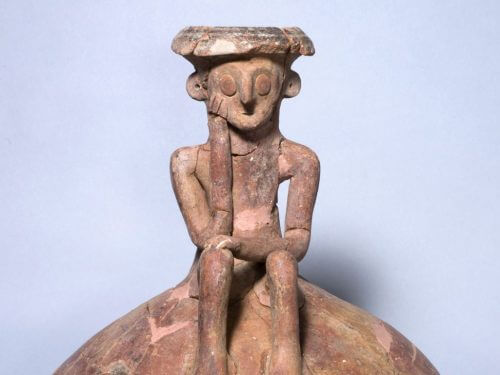The tool was discovered alongside daggers, an ax head and arrowheads, which were apparently buried as burial offerings for one of the dignitaries of the community

An impressive and unusual Pech (small urn) pottery from the Middle Bronze Age was uncovered in an archaeological dig by the Antiquities Authority with the participation of students from the Land of Israel and Archeology course, which was recently held in the city of Yehud before the construction of residential buildings.
According to Gilad Yattah, the director of the excavation on behalf of the Antiquities Authority, "On the very last day of the excavation, an unusual pottery vessel bearing the figure of a man about 18 cm in size began to be revealed before our eyes and the eyes of the excited students. It seems that at first an invert, typical of the period, was prepared, and then the unique statue was added, which is not known in the research. The level of precision and care in the creation of the figurine already almost 4,000 years ago is extremely impressive. A turned neck was used as the basis for the creation of the upper part of the figure, after which the sculptor added hands, feet and face. It can be seen that the figure's face seems to be leaning on her hand, in a way that gives her a look of contemplation." Yatah adds that "it is not clear if the figure was made by the potter who made the reverse, or by another craftsman".
Efrat Zilber, the professor for Land of Israel Studies and Archeology at the Ministry of Education, emphasizes that "the archaeological excavations provide an opportunity for an empowering experience that connects the students to the past of our country. While uncovering findings, learning is done in an experiential way of research methods in archaeology. The students meet experts in their field, who share their knowledge with the students, enriching the students and enriching their world."
In addition to the unique pottery, other tools and metal items were found such as daggers, arrow heads, an ax head, sheep bones and possibly donkey bones. According to Yattah, "It seems that these are burial offerings, which were placed in honor of a person of important status in the community. In the ancient world, it was believed that the objects that are buried next to the person continue with him to the next world. To the best of my knowledge, a burial assemblage so rich in finds, which also includes such a unique pottery, has not been discovered to this day in Israel."
The excavation also uncovered diverse evidence of life that existed in the place as early as 6,000 years ago - among other things, pits and shafts were uncovered in which thousands of fragments of pottery, hundreds of flint and basalt vessels, animal bones, and a pot - a unique tool used in the Chalcolithic period for churning butter. According to Yela Maklis, the mayor of Yehud Monoson, "In the coming months we will begin the establishment of a special archaeological park in the heart of the city of Yehud, which the younger generation will be able to take an active part in excavating and discovering findings from the past, while learning about the local heritage. It is important for us to expose the younger generation to the assets of culture and history and integrate them into our lives, as part of the education provided here in the city."
The students of the Land of Israel Studies and Archeology major participate in the archaeological digs as part of the new training course of the Antiquities Authority and the Ministry of Education, which seeks to connect the past and train the archaeologists of tomorrow. Students who choose this track as part of the alternative assessment for matriculation, participate in an excavation week. They experience the variety of roles involved in excavation, discuss the research questions and the archaeological considerations, and record the excavations in an 'excavation journal' as part of the research work.
"Suddenly I saw a lot of archaeologists and important people coming, examining and marveling at something that was uncovered in the ground," says Roni Krisher, a student majoring in Israel and archeology at the Rabbi's Studio in Ramat Gan. They immediately called us all to see the amazing statuette and explained to us that this is a rare discovery that you don't see every day. It's exciting to be part of an excavation whose findings will reach museums."

3 תגובות
"The thinking man" Bronze Age version - they made pottery.
The 20th century version, by Rodin, is made of bronze.
And someone who lived between these two creators has already said: What has been, will be, and what we will do, will be done; And there is no new moon under the sun. There is a thing that will say see-this, it is new: it was already forever, which was before us.
Despite what is taught in schools based on the Bible, the Canaanite cultures of sorts that were in the land long before the immigration of Israel, were rich cultures both materially and spiritually.
Enough Jew